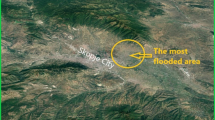Summary
This research is aimed at exploring real-data model simulations of two severe rainstorms and gaining insight into the predictability of mesoscale flood environment based on currently available observations and modeling techniques. The two events are the Rapid City, SD flood of 10 June 1972 and the Big Thompson, CO flood of 31 July 1976. In both cases the synoptic settings prior to the onset of heavy precipitation are quite similar and may be characterized as baroclinically inactive. The meteorological processes triggering the outbreak of the flash floods are carefully examined.
For the Big Thompson case, the models properly delineated the mesoscale flood environment, but for the Rapid City case, the models failed to produce any flood conditions despite the well-simulated large-scale circulation. The uneven performance of the models could be attributed to the difference in the triggering mechanisms between the two events. In the Big Thompson case, the excessive rainfall was mainly correlated with a surface frontal disturbance, while in the Rapid City case, the onset of the flash flood was caused by a short-wave trough in the lower troposphere.
In summer low-level short-wave disturbances frequently develop over the arid highlands in the western United States. The genesis of these weak systems is not well understood and deserves further study so as to reveal their role in organizing mesoscale rainstorms over the rugged terrain.
Similar content being viewed by others
References
Anthes, R. A., 1983: A review of regional models of the atmosphere in middle latitudes.Mon. Wea Rew.,111, 1306–1335.
Byers, H. B., 1974:General Meteorology. New York: McGraw-Hill, 461 pp.
Caracena, F., Maddox, R. A., Hoxit, L. R., Chappell, C. F., 1979: Mesoanalysis of the Big Thompson storm.Mon. Wea. Rev.,107, 1–17.
Chang, C.-B., 1989: Impact of moist process on the kinetic energy transformation during a rapid cyclogenesis over the East China Sea.Papers Meteor. Res.,12, 191–204.
Chang, C.-B., Perkey, D. J., Kreitzberg, C. W. 1981: A numerical case study of the squall line of 6 May 1975.J. Atmos. Sci.,38, 1601–1615.
Chang, C.-B., Perkey, D. J., Kreitzberg, C. W., 1986: Impact of missing wind observations on the simulation of a severe storm environment.Mon. Wea. Rev.,114, 1278–1287.
Gadd, A. J., Keers, J. F., 1970: Surface exchanges of sensible and latent heat in a 10-level model atmosphere.Quart. J. Roy. Meteor. Soc.,96, 297–308.
Kreitzberg, C. W., Perkey, D. J., 1976: Release of potential instability: Part I: A sequential plume model within a hydrostatic primitive equation model.J. Atmos. Sci.,33, 456–475.
Kuo, Y.-H., Cheng, L., Bao, J.-W., 1988: Numerical simulation of the 1981 Sichuan flood. Part I: Evolution of a mesoscale southwest vortex.Mon. Wea. Rev.,116, 2481–2504.
Maddox, R. A., Caracena, F., Hoxit, L. R., Chappell, C. F., 1977: Meteorological aspects of the Big Thompson flash flood of 31 July 1976. U.S. Department of Commerce, NOAA/ERL, 83 pp.
Maddox, R. A., Chappell, C. F., Hoxit, L. R., 1979: Comparison of meteorological aspects of the Big Thompson and Rapid City flash floods.Mon. Wea. Rev.,106, 375–389.
Maddox, R. A., Hoxit, L. R., Chappell, C. F., Caracena, F., 1978: Synoptic and meso-alpha scale aspects of flash flood events.Bull. Amer. Meteor. Soc.,60, 115–123.
O'Brien, J. J., 1970: A note on the vertical structure of the eddy exchange coefficient in the planetary boundary layer.J. Atmos. Sci.,27, 1213–1215.
Perkey, D. J., 1976: A description and preliminary results from a fine-mesh model for forecasting quantitative precipitation.Mon. Wea. Rev.,104, 1513–1526.
Perkey, D. J., Kreitzberg, C. W., 1976: A time-dependent lateral boundary scheme for limited-area primitive equation model.Mon. Wea. Rev.,104, 744–755.
Stull, R., 1988,An Introduction to Boundary Layer Meteorology, Dordrecht, Netherlands: Kluwer Academic Publishers, 666 pp.
Thompson, H. J., 1972: The Black Hills flood.Weatherwise,25, 162–167.
Zhang, D.-L., Fritsch, J. M., 1986: Numerical simulation of meso-∫ scale structure and evolution of the 1977 Johnstown flood. Part I: Model description and verification.J. Atmos. Sci.,43, 1913–1943.
Author information
Authors and Affiliations
Additional information
With 23 Figures
Rights and permissions
About this article
Cite this article
Chang, C.B., Perkey, D.J. Numerical simulations of mesoscale flood environment. Meteorl. Atmos. Phys. 55, 17–32 (1995). https://doi.org/10.1007/BF01029599
Received:
Revised:
Issue Date:
DOI: https://doi.org/10.1007/BF01029599




